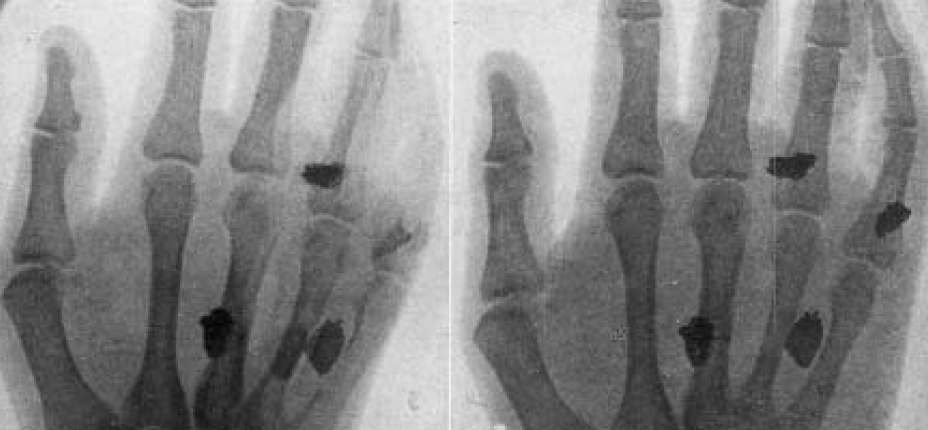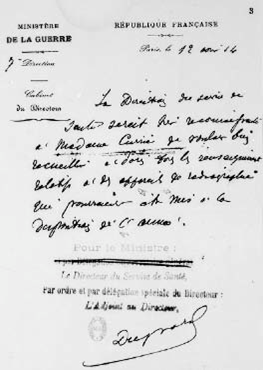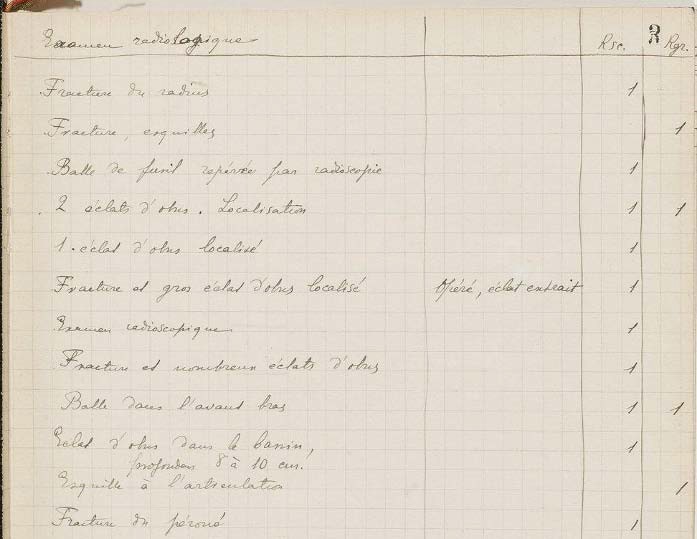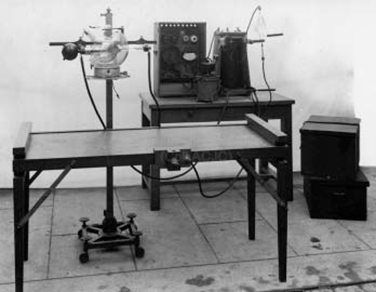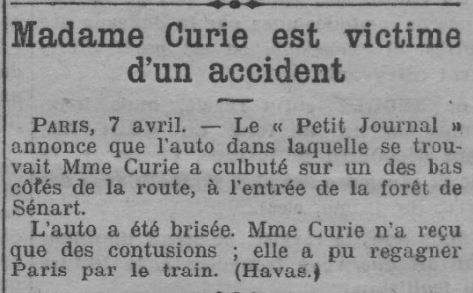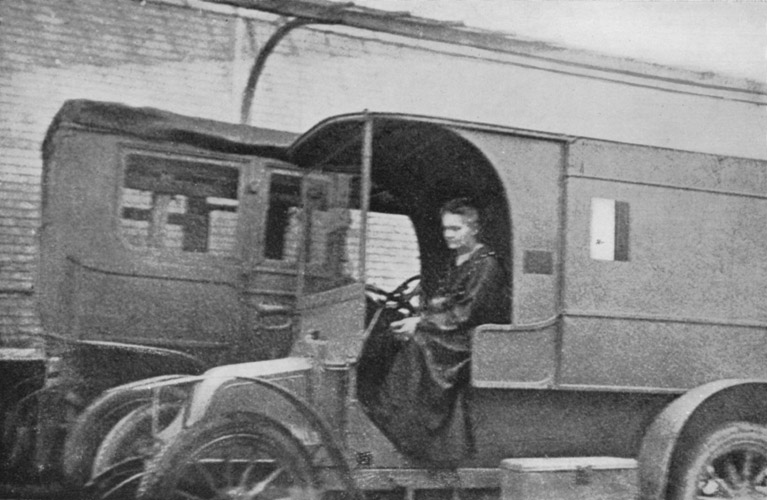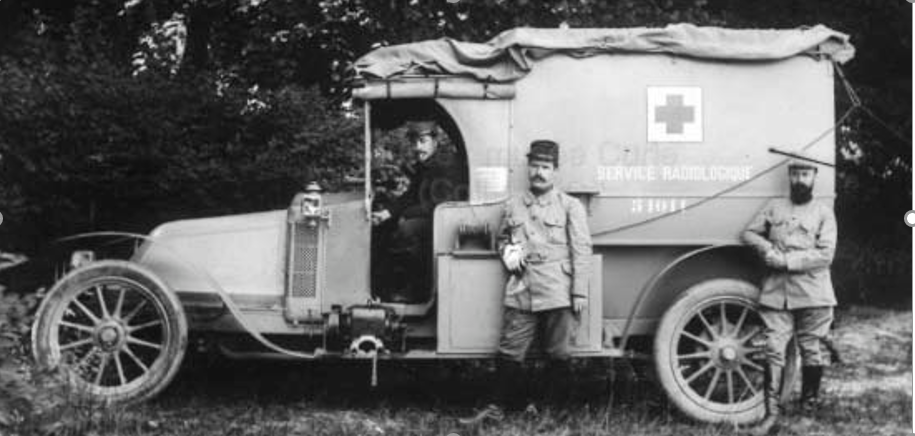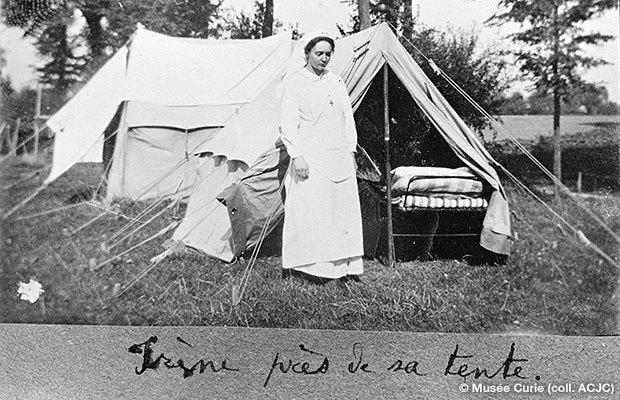- A first in its time and an honour that has remained rare: after her, only three other researchers have obtained the Holy Grail of scientific awards twice. 120 years after the creation of the Nobel Prize, Marie Curie is still the only one to have obtained the award in two different disciplines.
- The award goes to the German Wilhelm Röntgen in 1895, discoverer of X-rays.
- Joyfully despised, moreover. One of Dr. Béclère's colleagues scornfully accused him of demeaning medicine by reducing it to photography.
Medical History: Marie Curie on the frontline
Marie Curie is associated with many subjects, and rightly so: With two Nobel prizes won within eight years of each other, she remains one of the most famous scientists of the 20th century.
Translated from the original French version.
"Dear Irène, dear Eve, things seem to be going badly: we are expecting mobilisation at any moment. [...] You and I, Irène, will try to make ourselves useful."
- Letter from Marie Curie to her daughters, 1 August 1914 -
The least we can say is that Marie Sklodowska-Curie was not just anyone when the First World War broke out in the summer of 1914. A woman of science of worldwide stature, she won two Nobel Prizes1. The first, in physics, was shared in 1903 with her husband Pierre Curie and Henri Becquerel. To put it simply, Henri was awarded for "the discovery of spontaneous radioactivity", and Marie and Pierre "for their research on the radiation phenomena discovered by Professor Becquerel" - Henri, that is - and in particular the radioactive properties of polonium.
Marie Curie was awarded a second prize in 1908 for her work in chemistry. This time the Swedish Academy rewarded her for isolating radium and demonstrating that it was indeed a metal. A teacher at the Sorbonne in 1914, she was a figure whose career was all the more spectacular because she had established herself despite having experienced a great deal of xenophobia - Marie Sklodowska was Polish by birth - and the assumed misogyny that characterised the society of her time in general, and the scientific world in particular.
Cover image: X-ray photograph of a hand containing 4 shrapnel holes - 1917 (ACJC)
That is the one side. On the other side, Marie Curie was not spared by life’s challenges. At the age of 47, she had already lost her husband, killed in 1906 in a traffic accident. This tragedy was compounded by another, linked to the publication in 1911 by the scandal press of a series of letters suggesting that Marie Curie and the physicist Paul Langevin were having an affair - but Paul Langevin was married. The rumour was never confirmed and was exploited by nationalist newspapers to an extent and with a violence that is hard to imagine: Accused of "breaking up a French household", the woman whom the extreme right-wing press described as a simple "Polish student" was attacked with a staggering brutality that almost caused her to miss her second Nobel Prize. The Academy begged her not to go to the reception of her prize, a request that Marie Curie - known to be not very practical when people are looking to find fault in her - was happy to comply with on her way to Stockholm.
Front line in the early hours
Three years later, World War I broke out. Marie Curie, who had been head of the Radium Institute since 1909, decided to temporarily stop her research and turn to radiography. Although she had not invented this discipline2, she quickly grasped its medical value thanks to a physician from the Belgian Army Medical Service, Frans Daels.
Stationed at the military hospital in Veurne, on the French-Belgian border, Frans Daels had a front-row seat to see the damage caused by a conflict of a brutality never before seen in human history. From the very first days, hundreds of horribly mutilated soldiers arrived in his wards with extremely serious wounds. Machine gun bullets, shrapnel, metal balls from shrapnel... Daels, a gynaecologist by trade, alerted Marie Curie. He knew her because he had discussed with her the potential therapeutic properties of radium in the treatment of certain female cancers.
X-rays, he argued, would be extremely useful in helping surgeons to locate shrapnel in the flesh, to measure the exact extent of the damage and to reduce mortality. At a time when antibiotics did not exist, a piece of shrapnel or a splinter of wood shot through the flesh always or almost always became infected, with the attendant risk of lymphangitis or gangrene.
From Paris, Marie Curie reacted immediately. Just ten days after the outbreak of war, she received permission from the Ministry of the same name to set up a team of radiology technicians, before becoming head of the Red Cross radiology department. At the same time, she was trained in the rudiments of radiological examination by the radiologist Antoine Béclère and made an inventory of the equipment available, which was quickly done. The whole of France had a total of twenty or so, far from the front and used by less than 200 specialists.3
"The Direction of the Health Service would be very grateful to Madame Curie if she would collect all the information relating to X-ray machines that could be made available to the Army." Paris, 12 August 1914 (Gallica/BNF)
In the press, Marie Curie defends the merits of radiology: "On the battlefield, at the very moment when the wounded man is brought back from the line of fire, we can instantly realise the care that his case requires, the usefulness of transporting him or, on the contrary, of dressing him on the spot. Many complications will thus be avoided and many lives saved", she explained in the Figaro of 17 September 1914.
Close to combat
The question was how to make the system effective. At the front, the doctrine in force in the first few weeks was to evacuate soldiers to the rear, sometimes very far from where they had been hit, so as not to saturate the health services at the front. It was, above all, a great loss of luck for combatants who had been carried off in the conditions we can imagine.
The stabilisation of the front in the autumn changed the situation. While the conflict turned into trench warfare, the French army reorganised the care of the wounded. Convinced that they should be moved as little as possible, Marie Curie decided to set up mobile radiological units with the necessary equipment. In other words, she created small mobile radiology practices by fitting out vehicles large enough to accommodate the necessary equipment and operators.
The first casualties treated by Marie Curie in the radiology car E, recorded in her notebook (Gallica/BNF)
On paper, it is simple. On the front, it is more delicate. Marie Curie then called on all the networks at her disposal. She committed her own funds, solicited wealthy families, went round the kitchen staff and managed to have around twenty vehicles fitted out by car body designers with the financial support of the Union des Femmes de France (Women’s Union of France) and the Patronage National des Blessés (National Protectorate of the Wounded).
In four years, Marie Curie never let up in her efforts. The fleet gradually grew, with the help of the Red Cross and manufacturers such as Renault and Peugeot. Before the war, there were only 21 radiology stations in France, but Marie Curie alone created 250 in hospitals, in addition to the ambulances.
Little Curies at the front
With an average speed of almost 50 km/h on a good day, these small mobile radiology practices could get as close as possible to the battlefields, thus limiting the patients' travel to receive healthcare. Inside, these cars house a 110-volt dynamo connected to the engine to power an X-ray tube, the necessary photographic equipment, curtains, a few rudimentary screens and several pairs of gloves to protect the hands of the operators.
X-ray equipment in the vehicles
Each car accommodated three people: a physician, a technical assistant and a driver, all of whom were non-mobilised civilians. Women quickly took their place in these teams. While her daughter Irène became increasingly autonomous at the front, Marie Curie trained more than 150 female radiology technicians at the Radium Institute in Paris. These were often very young women who were learning to master the necessary knowledge of mathematics, physics and anatomy before being sent to the combat zones.
Officially called "radiological ambulances", these cars that travelled the roads of the north and east, close to the trenches, were quickly nicknamed "P'tites Curie" (Little Curies) by the soldiers. During the conflict, Marie Curie paid her personal dues. In April 1915, she ended up in a ditch without serious consequences: Sitting at the back of the vehicle, she was hit by boxes of equipment. The following year she obtained her "certificate of competence for driving petrol cars". Between 1914 and 1918, the physicist drove herself on 45 missions, including 11 in Belgium.
Headline: “Madame Curie falls victim to an accident”
Marie Curie driving a "Petite Curie" - October 1917 (DR)
The dynamo is placed on the footboard - 1915 (DR)
Better still, one Curie brings forth another: In October 1914, the researcher was joined by her daughter Irène, barely 18 years old but determined to do her bit, despite the harshness of the conflict. Irène even passed her nursing diploma the following year. Creil, Funes, Joinville, Poperinge, Amiens, Reims, Verdun... Together, Marie and Irène Curie examined over 1,200 wounded in four years. In a letter written the day after the war, Marie confided: "To hate the very idea of war, it is enough to see once what I have seen so often during all these years: Men and boys brought to the ambulance, in a mixture of mud and blood, many dying from their wounds and many others recovering but slowly and painfully after months of suffering."
(DR)
Reputed to be distant and sometimes cold in her work, Marie Curie showed compassion and listening skills that reassured them, wrote a witness: "Some peasants and workers were frightened by the apparatus and asked if the examination would hurt them. Marie reassures them: ‘You'll see, it's like a photograph’. She has a lovely voice, light hands, a lot of patience and an immense respect for human life.”
Often, the examination is decisive, Marie Curie emphasised in an essay published in 1923 titled “La radiologie et la guerre” (Radiology and War). "I have kept the memory (...) of a young wounded man who had been wasting away for several weeks, with a fractured pelvis. We had little hope of saving him (...) Having first taken an X-ray of the pelvis, we proceeded to X-ray the lower limbs. This revealed a shrapnel of considerable size above the knee, which was located and immediately extracted from a pocket of pus with a large quantity of liquid. It was not believed at the time that this operation (...) would have a great effect on the condition of the wounded man (...). However, I learned that, from the very day of the operation, the wounded man's condition improved rapidly and soon became quite satisfactory. The block of cast iron contained in the thigh had obviously sustained a large suppuration and a regular poisoning of the organism. As soon as this cause of morbid condition had disappeared, the young organism took over again and the wounded man, who had been considered lost, was in a position to repair his serious bone lesions."
As for the grateful Fatherland, we'll have to wait and see
The misogynistic and sometimes xenophobic reflexes that were expressed during the Langevin affair have not disappeared, however. It is hard to believe nowadays, but Marie Curie's initiative was not unanimously supported, far from it. In the French army, as well as in the Belgian forces, some officers were annoyed to see a woman who was certainly famous but a simple civilian going back and forth to the front.
"I see myself obliged to ask you to make a request to the Minister of War (...) I asked for a permit to go there [to a hospital] with the X-ray car (...) I learned that I could not obtain this permit, and this by virtue of new provisions relating to women and forbidding them to use military cars (...)"
"It seems that in spite of all the results obtained, one can never succeed in gaining the confidence of military leaders and securing their support (...) It is no exaggeration to say that we are spending the greater part of much of our activity in fruitless endeavours; it is probable that we will have been unable to respond to an urgent call for service, and that, as a result, we will have to deplore the infirmity or death of several wounded."
- Request for help from Ernest Lavisse, President of the Patronage of the Wounded (February 1915) -
A question of the pre-eminence of the military over the civilian, a question of posture too, but still nothing to impress Marie Curie, who happily sent the director of the Belgian Military Medical Service packing. After receiving an inflammatory letter from him, she replied that he could go and boil an egg - in a more polite version - and said: “The King and Queen of the Belgians have both expressed their wish to see me continue my efforts”. End of the debate.
All in all, more than a million wounded allied soldiers underwent an X-ray examination between 1914 and 1918. This examination will have largely contributed to saving the lives of many of them. And yet... as a pioneer and organiser of the necessary operational tool, the woman who had made this effort possible did not receive even a shadow of official recognition after the conflict. “She got nothing", wrote Eve Curie in the biography she devoted to her mother years later. “After a few weeks, the role she played in the great drama faded from memory.”
Who was to blame? Partly Marie Curie herself, who never sought awards and who, with her husband, had refused the Légion d’honneur (Legion of Honour, French Order of Merit) as a scientist. According to her daughter, she would have accepted it as a military award. Partly the conservatism of a part of French society, already evident at the time of the Langevin affair. Finally, it was partly due to the irritation of the military staff, who were caught off guard by a scientist who had organised, better and faster than the army, a system and protocols that were essential for the proper treatment of the injured.
The essential point lies elsewhere. In La radiologie et la guerre (Radiology and War, 1921), Marie Curie sums up a salutary evolution as follows: The conflict will at least have had the merit of "assigning to radiology, as a means of medical diagnosis, a place in keeping with the services it is likely to render, not only in time of war but also in time of peace (...) It was to be expected that radiology would be a powerful aid in the examination of the wounded by war. Nevertheless, it can be said that the services it has been able to render in this respect have exceeded all expectations.”
Still rare in 1914, radiological examinations had become commonplace by 1918. After the war, France had 850 radiologists, 700 (!) of whom were trained during the war. The usefulness of radiology in surgery no longer needed to be demonstrated, and the progress made with the wounded by war had made commonplace a technology that still frightened many patients four years earlier. Marie Curie could then advocate a new use for X-rays, thanks to radiotherapy: "After the rays that reveal, come the rays that cure".
About the Author: In his Medical History articles, medical historian Jean-Christophe Piot relates with a certain rigour - and a certain freedom of tone - the most significant pages in the history of medicine.
